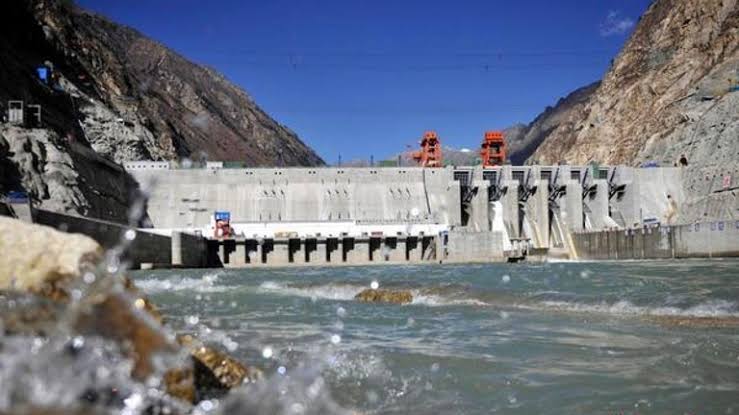World
China Begins Construction World’s Largest Dam

China has officially started building what it says will be the world’s largest hydropower dam.
The Motuo Hydropower Station, located in Tibet, sits on the Yarlung Tsangpo River, which flows into India as the Brahmaputra and eventually into Bangladesh as the Jamuna.
Premier Li Qiang launched the project on Saturday during a major ceremony.
Notably, the dam will cost about $167 billion and is expected to produce three times more energy than the current record-holder, the Three Gorges Dam.
Although China claims the project will support economic growth and environmental sustainability, the move has sparked regional concern.
India and Bangladesh worry about the potential environmental and geopolitical consequences.
In India, officials are urging China to adopt a transparent approach.
Earlier this year, India’s Ministry of External Affairs warned Beijing about ignoring the interests of downstream countries. Arunachal Pradesh Governor Pema Khandu even called the dam an “existential threat.”
According to him, a sudden release of water could destroy communities in the Siang basin. The Siang is the Indian section of the Yarlung Tsangpo.
“If China suddenly releases water, our entire Siang belt would be wiped out,” Khandu said.
He stressed that native tribes like the Adi people would suffer from flood damage and loss of farmland.
Similarly, Bangladesh has voiced its concerns. In February, Dhaka urged Beijing to provide detailed data on the dam’s impact.
Officials fear flooding and major disruptions to the country’s agriculture sector.
In addition to regional fears, environmentalists are also speaking out.
They warn that constructing massive dams in seismically active areas like Tibet can trigger landslides and irreversible ecological damage.
The project site lies within the world’s deepest canyon where the Yarlung Tsangpo makes its dramatic “Great Bend.”
Moreover, the design includes tunneling the river through five cascading stations, using a 20-kilometre-long underground system.
China plans to straighten sections of the river to improve power generation.
While Chinese media claim the project will help Tibet develop, the electricity will mostly go to eastern industrial cities.
Because of these risks, India has started building its own dam on the Siang River. Officials say this will serve as a countermeasure.
According to a 2020 Lowy Institute report, China’s upstream control gives it significant power over India’s water security.
Given these developments, calls for international regulation are rising.
South Asian nations and environmental groups continue to push for cooperation and transparency.
For now, however, Beijing appears committed to moving forward.
News
‘Gate of Hell’ Will Open on Gaza’– Israeli Defence Issues Finally Warning to Hamas

Israeli Defence Minister Israel Katz has issued a fierce warning to Hamas, declaring that Gaza City will face complete destruction if the militant group refuses to accept Israel’s conditions for ending the war.
Katz, in a statement shared on social media on Friday, August 22, 2025, used sharp words to describe Israel’s next steps.
He said the “gates of hell” would open on Hamas if it failed to disarm and release all hostages.
“Soon, the gates of hell will open upon the heads of Hamas’s murderers and rapists in Gaza until they agree to Israel’s conditions,” Katz wrote.
He added that if Hamas refused, Gaza City would suffer the same fate as Rafah and Beit Hanoun, two cities previously flattened by Israeli offensives.
His comments mark one of Israel’s strongest warnings since the escalation of the conflict.
The minister’s remarks came only hours after Prime Minister Benjamin Netanyahu announced that negotiations had been ordered to free the hostages held in Gaza.
Netanyahu explained in a video address that Israel’s military operation in Gaza City would not stop during talks. “Defeating Hamas and releasing our hostages go hand in hand,” he said.
The prime minister also confirmed the mobilisation of 60,000 reservists to join the offensive.
Meanwhile, mediators have been waiting for Israel’s response to a ceasefire plan that Hamas accepted earlier in the week.
The proposal suggests a phased release of hostages, but Israel insists that only a deal ensuring the release of all captives at once will be accepted.
Israel’s hardened stance has sparked growing concern worldwide.
International leaders have cautioned that an expanded assault on Gaza City could worsen the humanitarian disaster already unfolding in the region.
Gaza’s health ministry says more than 62,000 Palestinians, most of them civilians, have been killed since Israel’s military campaign began.
The United Nations considers these figures credible.
The war was triggered by Hamas’s October 2023 attack, which left 1,219 people dead in Israel, mostly civilians.
Since then, the conflict has intensified, with both sides showing little sign of compromise.
With Katz’s threat to turn Gaza City into rubble if demands are not met, the conflict appears to be entering an even deadlier stage.
The international community continues to press for a ceasefire, but Israel’s leadership insists that victory over Hamas and the release of all hostages remain its top priorities.
Africa
Canada Announces Permanent Residence Lottery Results for Foreign Workers

Canada has carried out a new Express Entry lottery, inviting thousands of skilled workers to apply for permanent residency.
Financial Express report that the Announcement which came on Wednesday, August 20, 2025, marks one of the most significant rounds this year.
Immigration, Refugees and Citizenship Canada (IRCC) invited 4,200 candidates in the latest Express Entry draw.
The invitations were sent under the no-program-specified category, which means candidates from all economic immigration programs were considered.
To qualify, candidates needed a Comprehensive Ranking System (CRS) score of at least 507 points.
This cut-off is higher than several recent rounds, showing rising competition in Canada’s immigration pool.
Breakdown of Recent Express Entry Draws
The August 20 general draw came just a week after Canada held two smaller, targeted draws.
On August 14, 2025, IRCC issued 1,500 invitations in a Healthcare category-based draw, with a minimum CRS of 430.
On August 13, 2025, another STEM occupation draw invited 1,000 candidates, with a CRS cut-off of 481.
This means Canada has invited more than 6,700 candidates in August alone, highlighting its steady demand for skilled workers.
Why Express Entry Remains Key
The Express Entry system is Canada’s main pathway for skilled migration. It manages applications for three major programs:
- Federal Skilled Worker Program (FSWP)
- Federal Skilled Trades Program (FSTP)
- Canadian Experience Class (CEC)
Through this system, candidates are ranked by CRS points based on age, education, work experience, language skills, and adaptability. Higher scores improve the chance of receiving an Invitation to Apply (ITA).
Impact of the Rising CRS
The 507-point cut-off has sparked concern among applicants.
Many worry that higher thresholds make it harder to qualify unless they boost their profiles with stronger English or French test results, higher education, or Canadian job offers.
Immigration experts note that Canada is prioritizing candidates who are more likely to integrate quickly into the economy.
With rising competition, applicants may need to explore provincial nomination programs (PNPs), which can add up to 600 extra CRS points.
Canada’s Immigration Targets
Despite higher CRS cut-offs, Canada’s immigration outlook remains ambitious.
The government has pledged to welcome 485,000 new permanent residents in 2024 and 500,000 in 2025.
Skilled workers make up a large share of this intake.
With labor shortages in sectors like healthcare, technology, and construction, Canada continues to use Express Entry to attract foreign talent.
What Applicants Should Do
Experts recommend that prospective migrants keep their profiles updated and monitor both general and category-based draws.
Targeted draws for healthcare, STEM, and trades occupations often have lower CRS cut-offs, giving candidates more opportunities.
For those struggling to meet the high CRS threshold, exploring study routes in Canada, provincial nominations, or job offers may increase chances.
The August 20 Express Entry draw shows Canada’s ongoing commitment to skilled immigration.
With over 4,200 invitations issued and CRS cut-offs climbing, the competition is intense.
However, the system continues to provide multiple entry points for determined applicants worldwide.
Africa
Japan Designates City as Hometown for Nigerians

The Japanese government has officially designated the city of Kisarazu as the hometown for Nigerians, marking a major step in strengthening cultural diplomacy and workforce collaboration between both nations.
The announcement was made during the ninth Tokyo International Conference for African Development (TICAD9) and confirmed by the Director of Information at Nigeria’s State House, Abiodun Oladunjoye.
According to the agreement, the Japanese government will introduce a special visa category for highly skilled and innovative young Nigerians who are willing to relocate to Kisarazu to live and work.
This initiative also extends to artisans and blue-collar workers from Nigeria who are ready to upskill and contribute to Japan’s economy.
At the same event, the Japan International Cooperation Agency (JICA) designated three other cities as hometowns for African nations:
Nagai in Yamagata Prefecture for Tanzania,
Sanjo in Niigata Prefecture for Ghana, and Imabari in Ehime Prefecture for Mozambique.
These hometown designations aim to foster manpower development, cultural exchanges, and economic partnerships that will benefit both Japan and the participating African countries.
Nigeria-Japan Partnership
Nigeria’s Charge d’Affaires and Acting Ambassador to Japan, Mrs. Florence Akinyemi Adeseke, received the certificate on behalf of Nigeria alongside Yoshikuni Watanabe, the Mayor of Kisarazu.
The ceremony highlighted the city’s longstanding relationship with Nigeria, as Kisarazu was the official host town for the Nigerian contingent during the 2020 Tokyo Olympics, where athletes trained and acclimatised before moving to the Olympic village.
Local Japanese authorities hope that designating Kisarazu as Nigerians’ hometown will boost the city’s population, enhance regional revitalisation, and strengthen bilateral cooperation.
Japan’s Vision for Africa
Japanese Prime Minister Shigeru Ishiba, in his address at TICAD9, announced $5.5 billion in new investments across Africa.
He stressed the importance of mutual understanding, local solutions, and collaborative development, focusing on three key areas:
Private sector-led sustainable growth,
Youth and women empowerment.
Prime Minister Ishiba also acknowledged Japan’s challenges with an ageing population and shrinking agricultural land, calling on African nations to support Japan while benefiting from expanded cultural and economic opportunities.
What This Means for Nigerians
For Nigerians, the recognition of Kisarazu as their official hometown in Japan provides more than symbolic value.
It creates new employment opportunities, encourages skills transfer, and opens a pathway for closer cultural integration between both nations.
This strategic move underscores Japan’s commitment to forging deeper ties with Africa, while offering Nigerians a platform to thrive abroad
News
Elon Musk’s SpaceX Launches Secretive US Military Spacecraft

SpaceX has once again captured global attention after successfully launching the US military’s mysterious X-37B space drone into orbit.
The Falcon 9 rocket roared into the night sky on Thursday, leaving behind bright trails of fire and smoke as it lifted off from NASA’s Kennedy Space Centre in Florida at exactly 11:50 pm (0350 GMT Friday).
The launch, streamed live on SpaceX’s platform, drew excitement from space enthusiasts across the world.
As the Falcon 9 ascended, the Crew Dragon Resilience capsule gleamed against the Florida night, setting the stage for what many believe could be one of the most significant missions in recent years.
The US Space Force confirmed that the X-37B will handle a wide range of test and experimentation assignments.
According to the service, the spacecraft will carry cutting-edge technologies designed to strengthen America’s space dominance.
Among its tasks, the X-37B will test next-generation laser communications and operate what the military calls the most advanced quantum inertial sensor ever deployed in orbit.
Officials explained that the spacecraft’s latest assignment, tagged “Mission 8,” will focus heavily on improving the resilience and efficiency of US space-based communications.
They also noted that the mission will explore ways to enhance security and reliability across military satellite systems.
The X-37B, often described as the Pentagon’s most secretive space project, resembles a smaller version of NASA’s retired space shuttles.
Roughly the size of a small bus, the unmanned vehicle measures about 30 feet in length, carries a 15-foot wingspan, and uses solar panels for power. Its compact design allows it to remain in orbit for extended periods, carrying out experiments shielded from public view.
Since entering service in 2010, the spacecraft has completed several long-duration missions.
Some of its earlier flights included scientific experiments for NASA, giving researchers insight into how space conditions affect advanced materials and biological samples.
Each mission has added to its reputation as a highly versatile orbital test vehicle.
Boeing originally built the drone for the US Air Force under the United Launch Alliance.
However, with the creation of the US Space Force, the program shifted under the new branch’s control, reflecting Washington’s increasing focus on space as a contested domain.
The secrecy around the X-37B continues to fuel speculation.
While the US military stresses the spacecraft’s role in research, many observers believe it also plays a critical part in testing technologies that could define the future of space warfare.
Regardless, its repeated launches underline America’s push to maintain an edge in the rapidly evolving space race.
This latest mission comes at a time when global powers are intensifying efforts to secure their presence in orbit.
Nations like China and Russia have accelerated their military space programs, heightening competition in what is quickly becoming the newest battlefield.
As the X-37B begins its eighth mission, questions remain about how long it will stay in orbit and what undisclosed objectives it might pursue.
What is certain, however, is that SpaceX has once again proved its capability to deliver some of the world’s most advanced payloads into space.
With Elon Musk’s company at the forefront, the partnership between private innovation and military ambition continues to reshape the future of space exploration and defense.
News
US Court Sentences Three Nigerians to 8-Year in Prison

Three US-based Nigerians have been sentenced to more than eight years in prison for their role in a $520,910 COVID-19 unemployment benefits fraud scheme.
The convicts Kamaldeen Karaole (24), Stephen Olamigoke (23), and Johnson Omodusonu (24) admitted to stealing unemployment benefits during the pandemic.
According to the US Department of Justice, the trio conspired with others abroad to file false claims using stolen personal information.
Between August and October 2020, the Nigerians stole 168 unemployment insurance debit cards belonging to real individuals.
Using these cards, they withdrew cash repeatedly at ATMs across Indianapolis.
Court documents revealed that 98 cards were used in 529 withdrawals, totaling $520,910. The cards came from California, Arizona, and Nevada.
“These benefits were intended for unemployed Americans during the COVID-19 crisis,” the US DoJ said. “Instead, the defendants exploited the system for personal gain.”
Each defendant faced charges of conspiracy, aggravated identity theft, and access device fraud.
Kamaldeen Karaole pleaded guilty to aggravated identity theft and conspiracy.
He was sentenced to four years and three months in prison plus two years of supervised release.
Stephen Olamigoke was sentenced to two and a half years plus two years of supervised release.
He also agreed to be deported to Nigeria after completing his term.
Johnson Omodusonu received two years in prison and two years of supervised release.
The court also ordered the three men to pay back $520,910 in restitution.
This case highlights a growing trend of international fraud schemes involving Nigerians abroad.
Just earlier this month, authorities charged Chukwuemeka Victor Amachukwu, a France-based Nigerian, with wire fraud and identity theft in the US. He allegedly caused losses of over $819,000 by hacking tax preparation firms.
The US Justice Department continues to warn against fraud networks exploiting unemployment and relief funds.
The sentencing of these three Nigerians sends a strong signal that the US will continue to pursue fraud cases aggressively.
While one will face deportation, all three will live with criminal records that mark them as part of a pandemic-era fraud scandal that shook public trust in unemployment aid systems.
-

 Featured4 days ago
Featured4 days agoYour Attacks on Peter Obi Are Petty, Stop It! Chekwas Rebukes Soludo
-

 News3 days ago
News3 days agoTension in Anambra community as senior police officer shoots kinsman dead
Colleagues, others try cover-up; victim's family fights back
-

 News6 days ago
News6 days agoAnambra South Bye-Election: APC Chief Rescues Deputy Gov Caught In Vote Buying From Angry Youths
By Chuks Collins, Awka
-

 News5 days ago
News5 days agoNigerian visa applicants must provide 5-yr social media history — US embassy
-

 Analysis6 days ago
Analysis6 days agoSystemic Sabotage: How APC, INEC Colluded To Undermine Amamgbo’s Senatorial Bid
By Arthur Ezechukwu
-

 Celebrity/Entertainment17 hours ago
Celebrity/Entertainment17 hours agoHow Nigerian TikToker Geh Geh Made ₦45 Million in One Night
-

 News3 days ago
News3 days agoTerrorist Organisation: APC, PDP Members in US, UK, France Risk Deportation
-

 Celebrity/Entertainment4 days ago
Celebrity/Entertainment4 days agoWhy single mothers can’t raise boys into proper men — Jim Iyke
-

 News6 days ago
News6 days agoBREAKING: Troops arrest Nigeria’s most wanted terror kingpin
-

 News2 days ago
News2 days agoVandal electrocuted while vandalizing Aba power infrastructure








